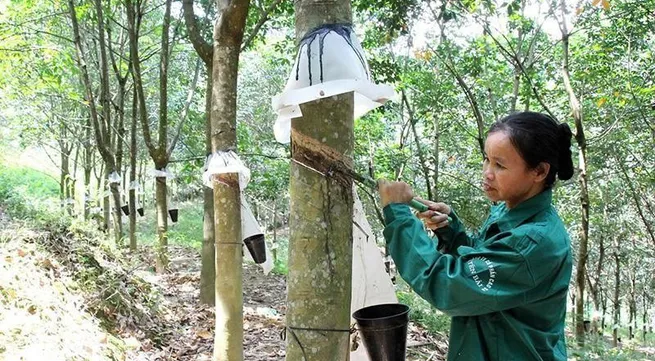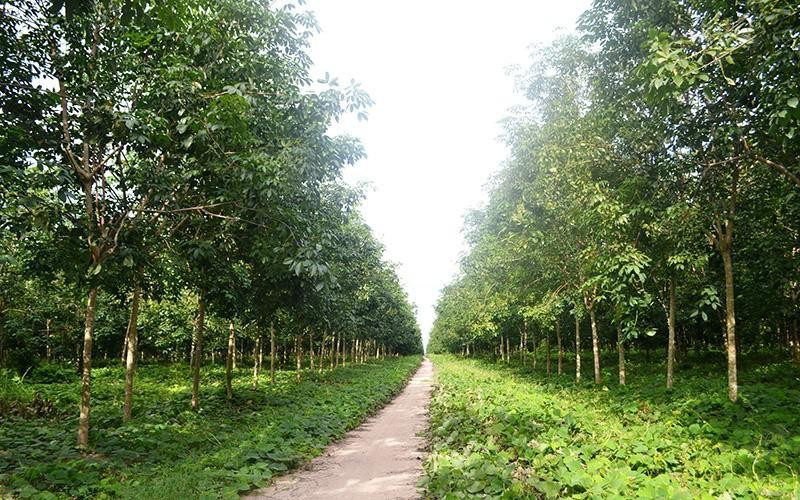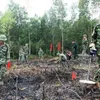Rubber sector needs to enhance its competitiveness

In 2022, the export target set for the rubber sector is 3.5 billion USD, of which, by the end of the second quarter, according to statistics of the General Department of Customs, rubber export turnover has reached 1.54 billion USD with an output of 772,000 tonnes, up more than 8% in volume and 28% in value over the same period in 2021.
Huge demand
In the first months of 2022, many kinds of exported rubber increased sharply in both volume and value over the same period from 2021. In the rubber import markets of Vietnam, China accounted for 99.7 % of the total export of natural and synthetic rubber mixtures. Vietnam became the second largest rubber supplier to China with nearly 1 billion USD, up 4.1% over the same period in 2021. According to the assessment of rubber importers, each month, China consumes about 500,000 tonnes of natural rubber, while the domestic supply can only meet about 115,000 tonnes. Therefore, China's rubber import demand is still quite large.
Along with the Chinese market, some other markets such as Europe and the US are also promising a lot of export potential, but Vietnamese rubber also faces significant challenges in terms of competitiveness with rivals, such as Thailand, Japan, and Myanmar. That forces businesses to improve product quality and reduce costs.
Currently, nationwide, there are more than 250 enterprises and private establishments engaged in rubber processing, with a capacity of more than 1.2 million tonnes per year. According to the assessment, the total capacity of the current processing facilities has exceeded the annual rubber output of Vietnam by 15-20%. According to the Association of Natural Rubber Producing Countries (ANRPC), the rubber industry will recover quickly due to the reopening of borders and the resumption of economic activities in the post-COVID-19 period.

Rubber garden of Loc Ninh Rubber One Member Co., Ltd.
The Import-Export Department, under the Ministry of Industry and Trade, also assessed that the export situation of the rubber industry in the first half of 2022 is very positive, and has tended to grow in both volume and value.
According to the forecast from now until the end of 2023, it is expected that the global rubber supply will be short; and the shortage may last until 2030 because the gap between supply and demand is widening.
Therefore, according to experts' forecasts in the coming years, Vietnam is likely to benefit from rubber exports because the world is still in short supply of this material. Vietnam's rubber exports to major markets will continue to increase and China will still be the largest rubber export market. From those optimistic signals, rubber enterprises must improve their production and business capacity and quickly access the market for stable and sustainable development.
Improving competitiveness
According to the Vietnam Rubber Association, Vietnam's rubber industry has become one of the most important sectors in the agro-forestry sector. The rubber areas throughout the country currently reach nearly one million hectares, of which 60% is smallholder rubber owned by 265,000 households. The rest is controlled by state-owned rubber companies. The rubber areas have not changed much in recent years.
Like many other agro-forestry economic sectors, the rubber industry relies mainly on export. In 2021, the industry's export turnover will reach nearly 7 billion USD, of which the turnover from rubber products will reach 3.7 billion USD and natural rubber will reach nearly 3.3 billion USD. China is the most important market for the output of Vietnam's natural rubber. The remaining major export markets include the US, India, the European Union (EU), Japan and the Republic of Korea.
Forest Trends policy analyst To Xuan Phuc, said that the world's rubber consumption is changing, including regulations on the import and export of this product. Therefore, Vietnamese rubber enterprises must change quickly to adapt flexibly.
Sustainable production of natural rubber in the future is an inevitable trend, which is both a challenge but also an opportunity for businesses to improve product value, and promote the production process with strict environmental and social compliance. Regulations on the legality and sustainability of rubber-based input materials to create products are increasingly strict. Despite being one of the three largest rubber-producing countries in the world, Vietnam's rubber industry is currently facing several limitations.
The rubber industry needs to make fundamental changes to address limitations and inadequacies, including limitations in forming links between the market, rubber companies, variable facilities and other industries.
Deputy General Secretary of the Vietnam Rubber Association Phan Thanh Van, said that in the current situation, manufacturers need to soon come up with solutions that businesses need to aim for; in which, priority is given to sustainable natural rubber products. At the same time, the State should create a synchronous legal framework, and encourage all economic sectors to participate in rubber production and trading in the direction of environmental protection, aiming to achieve national and international certification.





